A Comprehensive Study on Winter PM2.5 Variation in the Yangtze River Delta: Unveiling Causes and Pollution Transport Pathways
Abstract
:1. Introduction
2. Materials and Methods
2.1. Database Sources
2.2. Study Area and Model Settings
2.3. Analysis Methods
2.3.1. Quantitative Analysis of the Impact of Meteorology and Emissions
2.3.2. Backward Trajectory and Potential Source Analysis Method
3. Results
3.1. Variation Characteristics of PM2.5 Concentration in the YRD
3.2. Impact Assessment of Meteorology and Emission Changes on PM2.5 Concentration
3.3. Pollution Potential Sources and Transport Pathways in Major Cities
4. Conclusions
Author Contributions
Funding
Institutional Review Board Statement
Informed Consent Statement
Data Availability Statement
Conflicts of Interest
References
- Tao, T.H.; Shi, Y.S.; Gilbert, G.K.; Liu, X.Y. Spatiotemporal variations of air pollutants based on ground observation and emission sources over 19 Chinese urban agglomerations during 2015–2019. Sci. Rep. 2022, 12, 4293. [Google Scholar] [CrossRef] [PubMed]
- Liang, L.; Gong, P. Urban and air pollution: A multi-city study of long-term effects of urban landscape patterns on air quality trends. Sci. Rep. 2020, 10, 18618. [Google Scholar] [CrossRef]
- Zhang, Y.J.; Lei, R.Y.; Cui, S.J.; Wang, H.L.; Chen, M.D.; Ge, X.L. Spatiotemporal trends and impact factors of PM2.5 and O3 pollution in major cities in China during 2015~2020. Chin. Sci. Bull 2022, 67, 2029–2042. [Google Scholar] [CrossRef]
- Liu, J.; Shen, J.Y.; Cheng, Z.; Wang, P.; Ying, Q.; Zhao, Q.B.; Zhang, Y.H.; Zhao, Y.; Fu, Q.Y. Source Apportionment and Regional Transport of Anthropogenic Secondary Organic Aerosol during Winter Pollution Periods in the Yangtze River Delta, China. Sci. Total Environ. 2020, 710, 135620. [Google Scholar] [CrossRef] [PubMed]
- Li, R.; Li, Q.; Xu, J.; Li, L.; Ge, C.J.; Huang, L.; Sun, D.H.; Liu, Z.Y.; Zhang, K.; Zhou, G.Z.; et al. Regional Air Pollution Process in Winter over the Yangtze River Delta and Its Influence on Typical Northern Cities. Environ. Sci. 2020, 41, 1520–1534. [Google Scholar]
- Li, L.; Cai, J.L.; Zhou, M. Potential Source Contribution Analysis of the Particulate Matters in Shanghai During the Heavy Haze Episode in Eastern and Middle China in December, 2013. Environ. Sci. 2015, 36, 2327–2336. [Google Scholar]
- Xue, W.B.; Fu, F.; Wan, J.N.; Tang, G.Q.; Lei, Y.; Yang, J.T.; Wang, Y.S. Numerical study on the characteristics of regional transport of PM2.5 in China. China Environ. Sci. 2014, 34, 1361–1368. [Google Scholar]
- Miao, Y.C.; Liu, S.H.; Guo, J.P.; Yan, Y.; Huang, S.X.; Zhang, G.; Zhang, Y.; Lou, M.Y. Impacts of meteorological conditions on wintertime PM2.5 pollution in Taiyuan, North China. Environ. Sci. Pollut. Res. 2018, 25, 21855–21866. [Google Scholar] [CrossRef] [PubMed]
- Li, D.Y.; Wu, Q.Z.; Cheng, H.Q.; Feng, J.M.; Li, D.X.; Wang, Y.L.; Cao, K.; Wang, L.N. Numerical Study of the Future PM2.5 Concentration under Climate Change and Best-Health-Effect (BHE) Scenario. Environ. Pollut. 2024, 357, 124391. [Google Scholar] [CrossRef]
- Fang, C.S.; Li, X.L.; Li, J.; Tian, J.Q.; Wang, J. Impact of Meteorological Conditions on PM2.5 Pollution in Changchun and Associated Health Risks Analysis. Atmosphere 2024, 16, 616. [Google Scholar] [CrossRef]
- Li, L.; Li, Q.; Huang, L.; Wang, Q.; Zhu, A.S.; Xu, J.; Liu, Z.Y.; Li, H.L.; Shi, L.S.; Li, R.; et al. Air Quality Changes during the COVID-19 Lockdown over the Yangtze River Delta Region: An Insight into the Impact of Human Activity Pattern Changes on Air Pollution Variation. Sci. Total Environ. 2020, 732, 139282. [Google Scholar] [CrossRef] [PubMed]
- Luan, T.; Guo, X.L.; Guo, L.J.; Zhang, T.H. Quantifying the relationship between PM2.5 concentration, visibility and planetary boundary layer height for long-lasting haze and fog-haze mixed events in Beijing. Atmos. Chem. Phys. 2018, 18, 203–225. [Google Scholar] [CrossRef]
- Yang, Y.R.; Xiu, X.G.; Qu, Y.; An, J.L.; Jiang, R.; Zhang, Y.H.; Sun, Y.L.; Wu, Z.J.; Zhang, F.; Xu, W.Q.; et al. Characteristics and formation mechanism of continuous hazes in China: A case study during the autumn of 2014 in the North China Plain. Atmos. Chem. Phys. 2015, 15, 8165–8178. [Google Scholar] [CrossRef]
- Liang, R.M.; Yin, P.; Zhou, M.G. Long-term exposure to fine particulate air pollution and health effects: A review of recent cohort studies. J. Environ. Health 2016, 33, 172–177. [Google Scholar]
- Guo, X.B.; Wei, H.Y. Progress on the health effects of ambient PM2.5 pollution. Chin. Sci. Bull 2013, 58, 1171–1177. [Google Scholar]
- Huang, S.X. Air pollution and control: Past, present and future. Chin. Sci. Bull 2018, 63, 895–919. [Google Scholar] [CrossRef]
- Yu, C.; Zhao, T.; Bai, Y.; Zhang, L.; Kong, S.; Yu, X.; He, J.; Cui, C.; Yang, J.; You, Y.; et al. Heavy Air Pollution with a unique “non-stagnant” Atmospheric Boundary Layer in the Yangtze River Middle Basin Aggravated by Regional Transport of PM2.5 over China. Atoms. Chem. Phys. 2020, 20, 7217–7230. [Google Scholar] [CrossRef]
- Ji, D.; Li, L.; Wang, Y.; Zhang, J.; Cheng, M.; Sun, Y.; Liu, Z.; Wang, L.; Tang, G.; Hu, B.; et al. The heaviest particulate air-pollution episodes occurred in northern China in January, 2013: Insights gained from observation. Atmos. Environ. 2014, 92, 546–556. [Google Scholar] [CrossRef]
- Sun, Y.L.; Jiang, Q.; Wang, Z.F.; Fu, P.Q.; Li, J.; Yang, T.; Yin, Y. Investigation of the sources and evolution processes of severe haze pollution in Beijing in January 2013. J. Geophys. Res. Atmos. 2014, 119, 4380–4398. [Google Scholar] [CrossRef]
- Streets, D.G.; Fu, J.S.; Jang, C.J.; Hao, J.; He, K.; Tang, X.; Zhang, Y.; Wang, Z.; Li, Z.; Zhang, Q.; et al. Air quality during the 2008 Beijing Olympic Games. Atmos. Environ. 2006, 41, 480–492. [Google Scholar] [CrossRef]
- Dong, Z.X.; Wang, S.X.; Xing, J.; Chang, X.; Ding, D.; Zheng, H.T. Regional Transport in Beijing-Tianjin-Hebei Region and its Changes during 2014–2017: The Impacts of Meteorology and Emission Reduction. Sci. Total Environ. 2020, 737, 139792. [Google Scholar] [CrossRef]
- Hu, X.M.; Ma, Z.Q.; Lin, W.L.; Zhang, H.L.; Hu, J.L.; Wang, Y.; Xu, X.B.; Fuentes, J.D.; Xue, M. Impact of the Loess Plateau on the atmospheric boundary layer structure and air quality in the North China Plain: A case study. Sci. Total Environ. 2014, 499, 228–237. [Google Scholar] [CrossRef] [PubMed]
- Zhang, H.L.; Wang, Y.G.; Hu, J.L.; Ying, Q.; Hu, X.M. Relationships between meteorological parameters and criteria air pollutants in three megacities in China. Environ. Res. 2015, 140, 242–254. [Google Scholar] [CrossRef] [PubMed]
- Miao, Y.C.; Liu, S.H.; Sheng, L.; Huang, S.X.; Li, J. Influence of Boundary Layer Structure and Low-Level Jet on PM2.5 Pollution in Beijing: A Case Study. Int. J. Environ. Res. Public Health 2019, 16, 616. [Google Scholar] [CrossRef] [PubMed]
- Wang, X.Q.; Duan, W.J.; Zhu, J.X.; Wei, W.; Cheng, S.Y.; Mao, S.S. Nonlinear influence of winter meteorology and precursor on PM2.5 based on mathematical and numerical models: A COVID-19 and Winter Olympics case study. Atmos. Environ. 2022, 278, 119072. [Google Scholar]
- Huang, R.J.; Zhang, Y.; Bozzetti, C.; Ho, K.F.; Cao, J.J.; Han, Y.; Daellenbach, K.R.; Slowik, J.G.; Platt, S.M.; Canonaco, F.; et al. High secondary aerosol contribution to particulate pollution during haze events in China. Nature 2014, 514, 218–222. [Google Scholar] [CrossRef]
- Zhai, H.; Zhu, B.; Zhao, X.T.; Pan, C. Analysis of a heavy air pollution event in early winter in the Yangtze River Delta. China Environ. Sci. 2018, 38, 4001–4009. [Google Scholar]
- Hua, S.B.; Shi, H.D.; Wang, K.; Gao, J.J. Analysis of Meteorological Conditions for a Heavy Pollution Process in North China During 2016–2017 Winter. Meteor. Environ. Sci. 2018, 41, 47–53. [Google Scholar]
- Xiao, Z.M.; Xu, H.; Cai, Z.Y.; Li, P.; Liu, B.; Yuan, J.; Zheng, N.Y.; Tang, M.; Chen, K.; Deng, X.W. Characterization of Two Heavy Pollution Episodes in Tianjin in 2020. Environ. Sci. 2020, 41, 3879–3888. [Google Scholar]
- Chen, Y.B.; Xu, J.; He, Y.J.; Du, X.H.; Tang, W.; Meng, F. Model analytic research of typical heavy PM2.5 pollution periods in winter in Beijing. Res. Environ. Sci. 2016, 29, 627–636. [Google Scholar]
- Zhang, X.Y.; Xu, X.D.; Ding, Y.H.; Liu, Y.J.; Zhang, H.D.; Wang, Y.Q.; Zhong, J.T. The impact of meteorological changes from 2013 to 2017 on PM2.5 mass reduction in key regions in China. Sci. China Earth Sci. 2019, 62, 1885–1902. [Google Scholar] [CrossRef]
- Xu, Y.L.; Xue, W.B.; Lei, Y. Impact of meteorological conditions and emission change on PM2.5 pollution in China. China Environ. Sci. 2019, 39, 4546–4551. [Google Scholar]
- Lu, S.Z.; Shi, X.R.; Xue, W.B.; Lei, Y.; Yan, G. Impacts of Meteorology and Emission Variations on PM2.5 Concentration throughout the Country During the 2020 Epidemic Period. Environ. Sci. 2021, 42, 3099–3106. [Google Scholar]
- Qiu, Y.L.; Chen, L.; Zhu, J.; Ma, Z.Q.; Li, Z.M.; Guo, H.; Tang, Y.X. Impacts of Changes in Meteorological Conditions during COVID-19 Lockdown on PM2.5 Concentrations over the Jing-Jin-Ji Region. Environ. Sci. 2022, 43, 2831–2839. [Google Scholar]
- Zhao, L.F. Spatio-Temporal Characteristics of PM2.5 and Correlation Analysis of Atmospheric Composite Pollutants in Winter in the Yangtze River Delta. Master’s Dissertation, Zhejiang University, Hangzhou, China, 2018. [Google Scholar]
- Sulaymon, I.D.; Zhang, Y.X.; Hu, J.L.; Hopke, P.K.; Zhang, Y.; Zhao, B.; Xing, J.; Li, L.; Mei, S.D. Evaluation of Regional Transport of PM2.5 during Severe Atmospheric Pollution Episodes in the Western Yangtze River Delta, China. J. Environ. Manag. 2021, 293, 112827. [Google Scholar] [CrossRef] [PubMed]
- Mi, K.N.; Zhuang, R.L.; Liang, L.W.; Duan, Y.P.; Gao, J. Spatio-temporal evolution and characteristics of PM2.5 in the Yangtze River Delta based on real-time monitoring data during 2013–2016. Geogr. Res. 2018, 37, 1641–1654. [Google Scholar]
- Huang, X.Y.; Wang, L.; Pan, H.; Xie, F.F. Evolution trend and spatial differentiation characteristics of PM2.5 and PM10 in Yangtze River Delta urban agglomeration. Environ. Pollut. Control 2021, 43, 1309–1315. [Google Scholar]
- Ministry of Environmental Protection of the People’s Republic of China. HJ633–2012: Technical Requirements for Ambient Air Quality Index (AQI) (Trial); China Environmental Science Press: Beijing, China, 2012.
- Wang, Z.; Li, J.; Wang, Z.; Yang, W.; Tang, X.; Ge, B.; Yan, P.; Zhu, L.; Chen, X.; Chen, H.; et al. Modeling study of regional severe hazes over mid-eastern China in January 2013 and its implications on pollution prevention and control. Sci. China Earth Sci. 2014, 57, 3–13. [Google Scholar] [CrossRef]
- Li, J.; Yang, W.Y.; Chen, H.S.; Wang, Z.F.; Hu, B.; Song, T.; Li, J.J. Modeling study of atmospheric respirable particulate matter over East Asia. Acta Sci. Circumst. 2014, 34, 548–557. [Google Scholar]
- Wang, W.D.; Chen, H.S.; Wu, Q.Z.; Wei, L.F.; Wang, Z.F.; Li, C.; Chen, D.H.; Jiang, Z.M.; Wu, W.W. Numerical study of PM2.5 regional transport over Pearl River Delta during a winter heavy haze event. Acta Sci. Circumst. 2016, 36, 2741–2751. [Google Scholar]
- Wang, Z.F.; Xie, F.Y.; Wang, Q.X.; An, J.L.; Zhu, J. Development and Application of Nested Air Quality Prediction Modeling System. Chinese J. Atmos. Sci. 2006, 30, 778–790. [Google Scholar]
- Li, J.; Wang, Z.F.; Zhuang, G.; Luo, G.; Sun, Y.; Wang, Q. Mixing of Asian mineral dust with anthropogenic pollutants over East Asia: A model case study of a super-duststorm in March 2010. Atmos. Chem. Phys. 2012, 12, 7591–7607. [Google Scholar] [CrossRef]
- Li, J.; Wang, Z.; Wang, X.; Yamaji, K.; Takigawa, M.; Kanaya, Y.; Pochanart, P.; Liu, Y.; Irie, H.; Hu, B.; et al. Impacts of aerosols on summertime tropospheric photolysis frequencies and photochemistry over Central Eastern China. Atmos. Environ. 2011, 45, 1817–1829. [Google Scholar] [CrossRef]
- Zaveri, R.A.; Peters, L.K. A new lumped structure photochemical mechanismfor large-scale applications. J. Geophys. Res. Atmos. 1999, 104, 30387–30415. [Google Scholar] [CrossRef]
- Nenes, A.; Pilinis, C.; Pandis, S.N. ISORROPIA: A New Thermodynamic Equilibrium Model for Multiphase Multicomponent Inorganic Aerosols. Aquat. Geochem. 1998, 4, 123–152. [Google Scholar] [CrossRef]
- Odum, J.R.; Jungkamp, T.P.W.; Griffin, R.J.; Flagan, R.C.; Seinfeld, J.H. The atmospheric aerosol-forming potential of whole gasoline vapor. Science 1997, 276, 96–99. [Google Scholar] [CrossRef]
- Luo, G.; Wang, Z.F. A global environmental atmospheric transport model (GEATM): Model description and validation. Chin. J. Atmos. Sci. 2006, 30, 504–518. [Google Scholar]
- Athanasopoulou, E.; Tombrou, M.; Pandis, S.N.; Russell, A.G. The role of sea-salt emissions and heterogeneous chemistry in the air quality of polluted coastal areas. Atmos. Chem. Phys. 2008, 8, 5755–5769. [Google Scholar] [CrossRef]
- Yang, T.; Gbaguidi, A.; Yan, P.Z.; Zhang, W.D.; Zhu, L.L.; Yao, X.F.; Wang, Z.F.; Chen, H. Model elucidating the sources and formation mechanisms of severe haze pollution over Northeast mega-city cluster in China. Environ. Pollut. 2017, 230, 692–700. [Google Scholar] [CrossRef]
- Pan, Y.; Zheng, J.; Xiao, H. Simulation Evaluation of the Contribution of Typical PM2.5 Pollution and Trans-regional Transport to Ningbo Pollution in the Yangtze River Delta. Environ. Sci. 2023, 44, 634–645. [Google Scholar]
- Xu, Y.L.; Xue, W.B.; Lei, Y.; Zhao, Y.; Cheng, S.Y.; Ren, Z.H.; Huang, Q. Impact of Meteorological Conditions on PM2.5 Pollution in China during Winter. Atmosphere 2018, 9, 429. [Google Scholar] [CrossRef]
- Li, D.; Liu, J.; Zhang, J.; Gui, H.; Du, P.; Yu, T.; Wang, J.; Lu, Y.; Liu, W.; Cheng, Y. Identification of long-range transport pathways and potential sources of PM2.5 and PM10 in Beijing from 2014 to 2015. J. Environ. Sci. 2017, 56, 214–229. [Google Scholar] [CrossRef]
- Li, H.L.; He, Q.; Liu, X.C. Identification of long-range transport pathways and potential source regions of PM2.5 and PM10 at akedala station, central asia. Atmosphere 2020, 11, 1183. [Google Scholar] [CrossRef]
- Wang, J.; Zhang, M.; Bai, X.; Tan, H.; Li, S.; Liu, J.; Zhang, R.; Wolters, M.A.; Qin, X.; Zhang, M.; et al. Large-scale transport of PM2.5 in the lower troposphere during winter cold surges in China. Sci. Rep. 2017, 7, 13238. [Google Scholar] [CrossRef]
- Zhao, N.; Wang, G.; Li, G.H.; Lang, J.L.; Zhang, H.Y. Air pollution episodes during the COVID-19 outbreak in the Beijing-Tianjin-Hebei region of China: An insight into the transport pathways and source distribution. Environ. Pollut. 2020, 267, 115617. [Google Scholar] [CrossRef] [PubMed]
- Wang, X.D.; Yin, S.S.; Yang, J.; Yuan, M.H.; Zhang, R.Q.; Li, Y.S.; Lu, X. Characteristics, Meteorological Influences, and Transport Source of Ozone Pollution in Zhengzhou City. Environ. Sci. 2021, 42, 604–615. [Google Scholar] [CrossRef]
- Wang, Y.; Cai, F.H.; Wang, Y.H.; Liu, M. Transport Characteristics of Air Pollutants over the Yangtze Delta. Environ. Sci. 2008, 29, 1430–1435. [Google Scholar]
- Seibert, P.; Kromp-Kolb, H.; Baltensperger, U.; Jost, D.T.; Schwikowski, M. Trajectory Analysis of High-Alpine Air Pollution Data. Air Pollut. Model. Its Appl. X 1994, 18, 595–596. [Google Scholar]
- Hsu, Y.K.; Holsen, T.M.; Hopke, P.K. Comparison of hybrid receptor models to locate PCB sources in Chicago. Atmos. Environ. 2003, 37, 545–562. [Google Scholar] [CrossRef]
- Zhang, H.Y.; Cheng, S.Y.; Yao, S.; Wang, X.Q.; Zhang, J.F. Pollution Characteristics and Regional Transport of Atmospheric Particulate Matter in Beijing from October to November, 2016. Environ. Sci. 2019, 40, 1999–2009. [Google Scholar]
- Duan, S.G.; Jiang, N.; Yang, L.M.; Zhang, R.Q. Transport Pathways and Potential Sources of PM2.5 during the Winter in Zhengzhou. Environ. Sci. 2019, 40, 86–93. [Google Scholar]
- Wang, G.C.; Wang, J.; Xin, Y.J.; Chen, L. Transportation pathways and potential source areas of PM10 and NO2 in Tianjin. China Environ. Sci. 2014, 34, 3009–3016. [Google Scholar]
- Yan, S.M.; Wang, Y.; Guo, W.; Li, Y.; Zhang, F.S. Characteristics, Transportation, Pathways, and Potential Sources of Air Pollution During Autumn and Winter in Taiyuan. Environ. Sci. 2019, 40, 4801–4809. [Google Scholar]
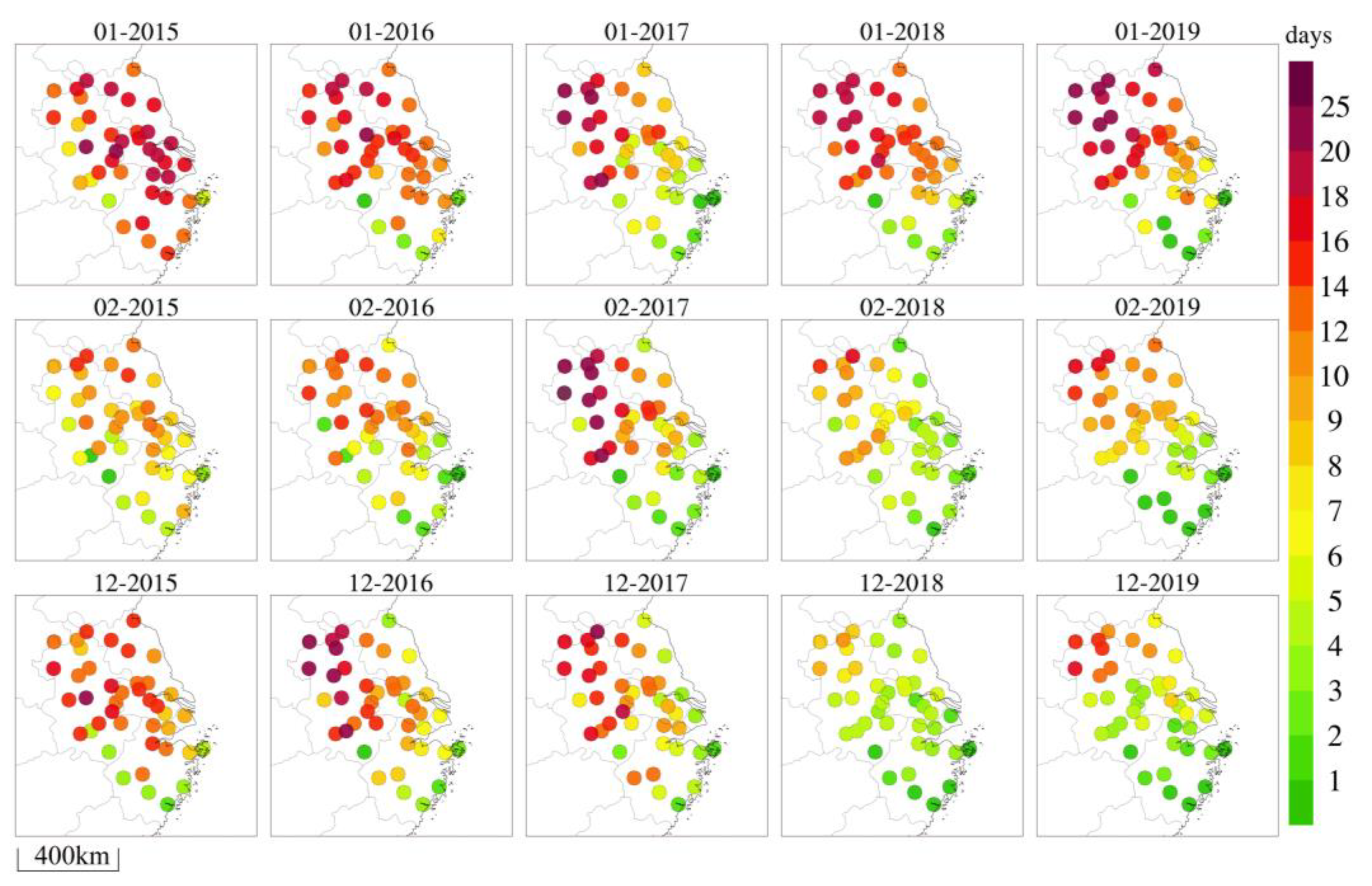
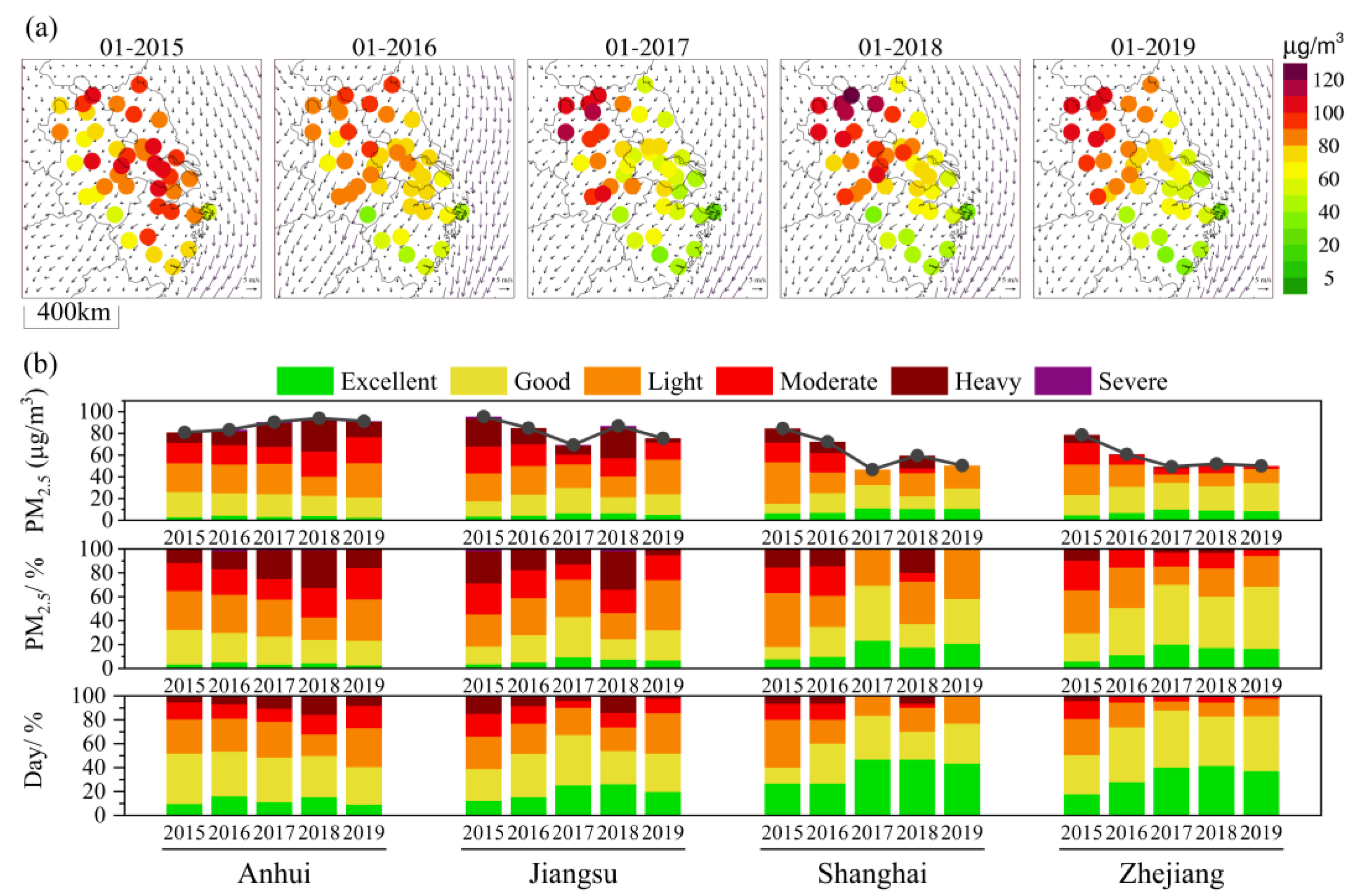
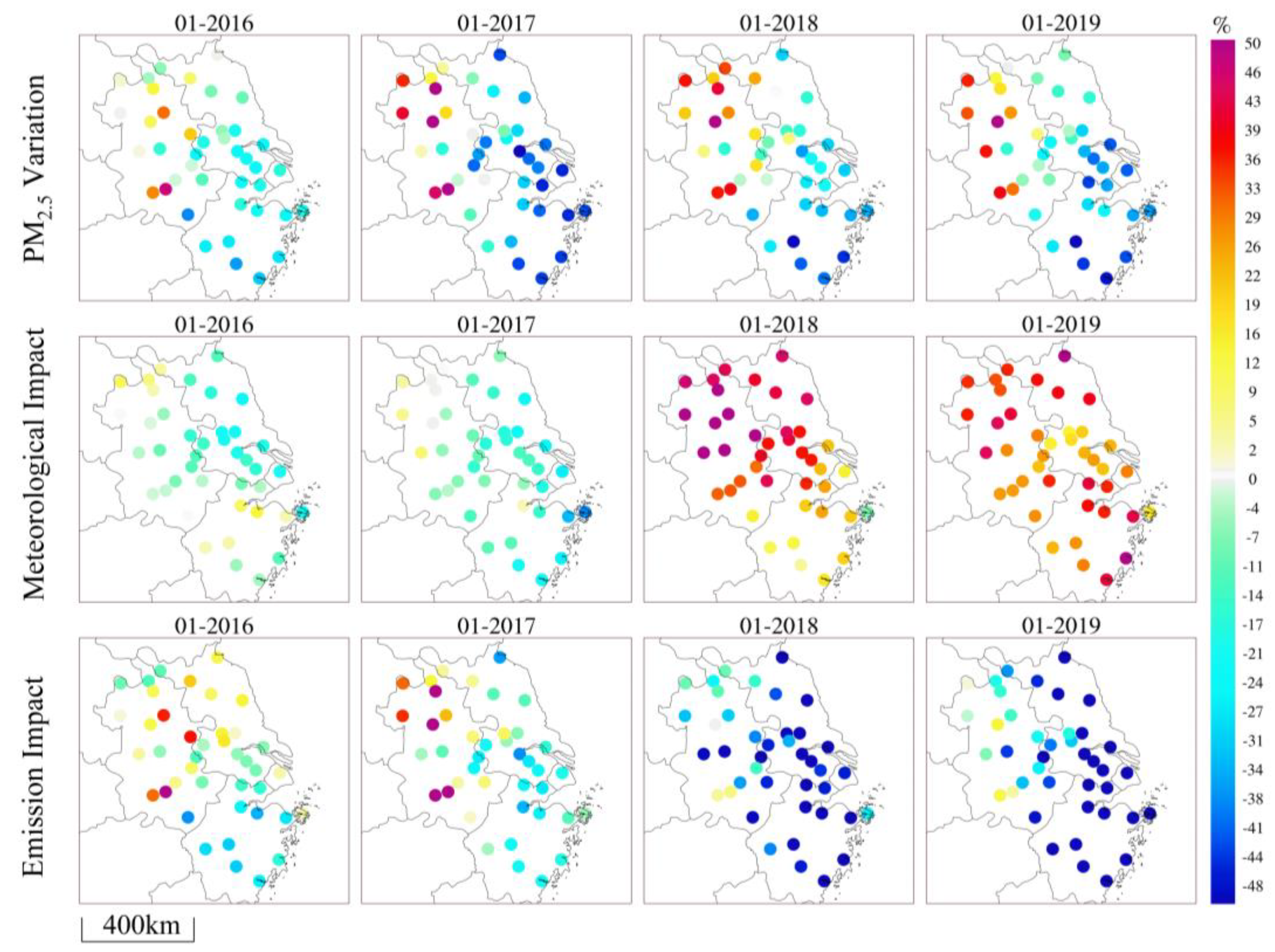
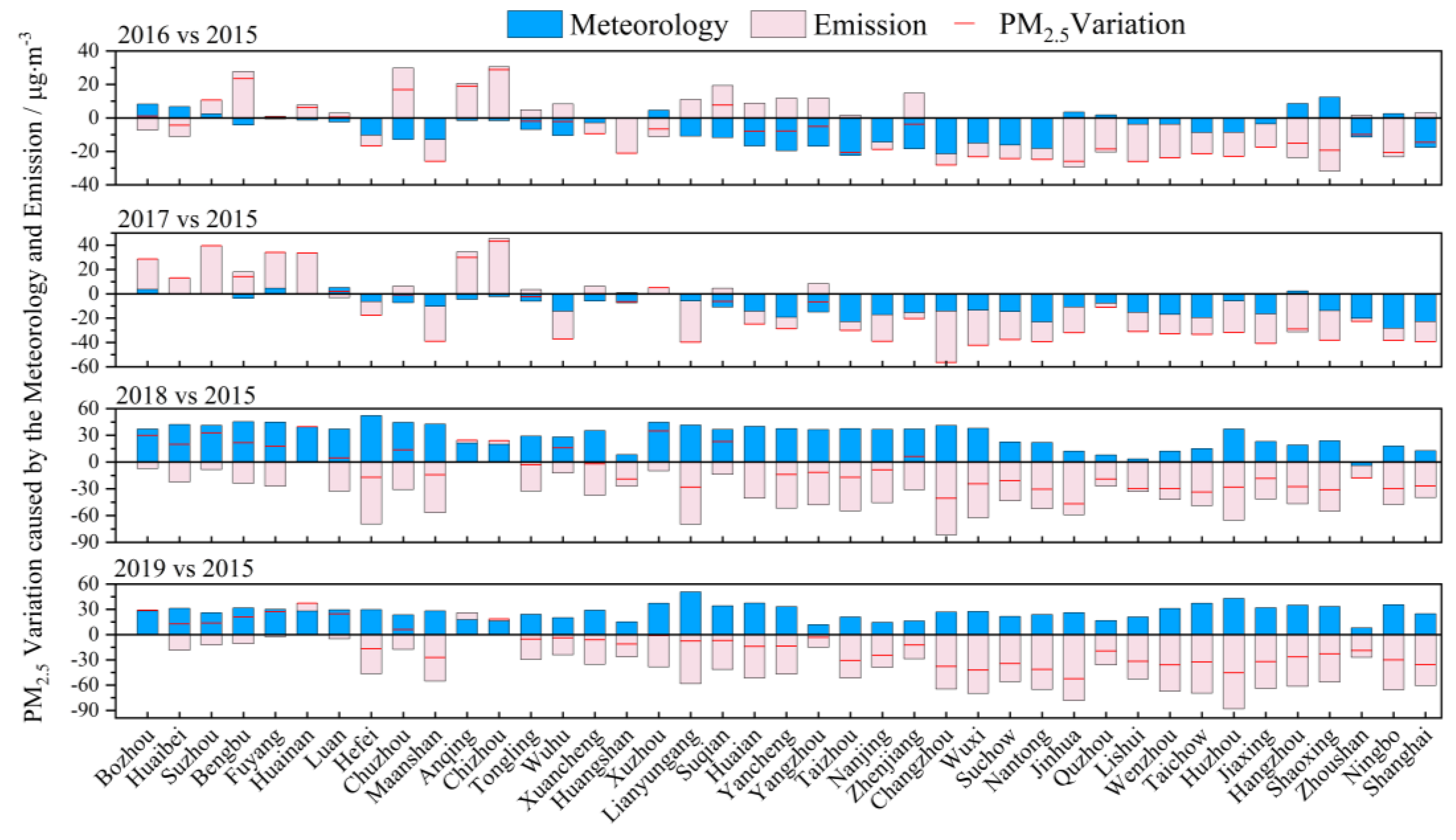
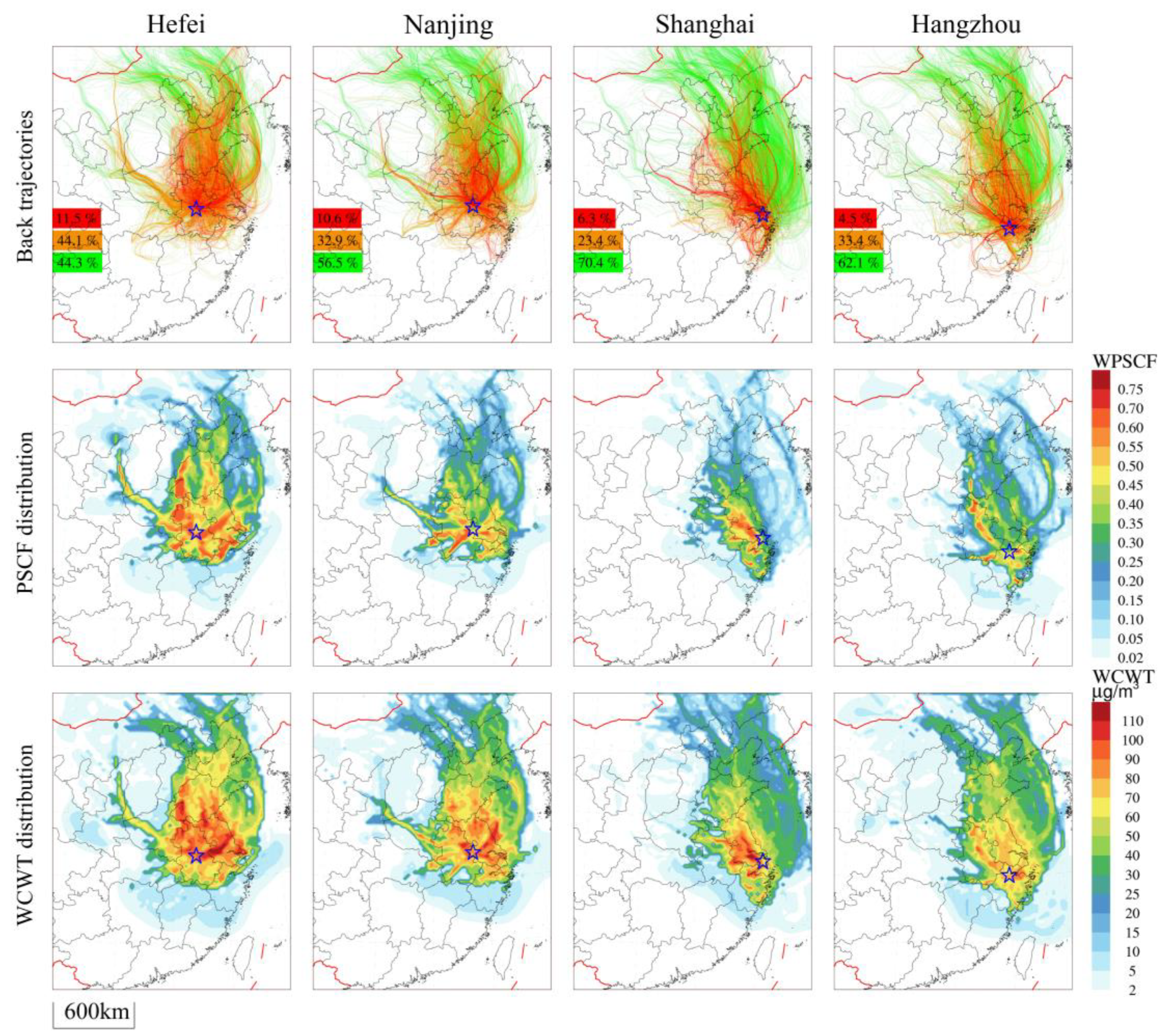
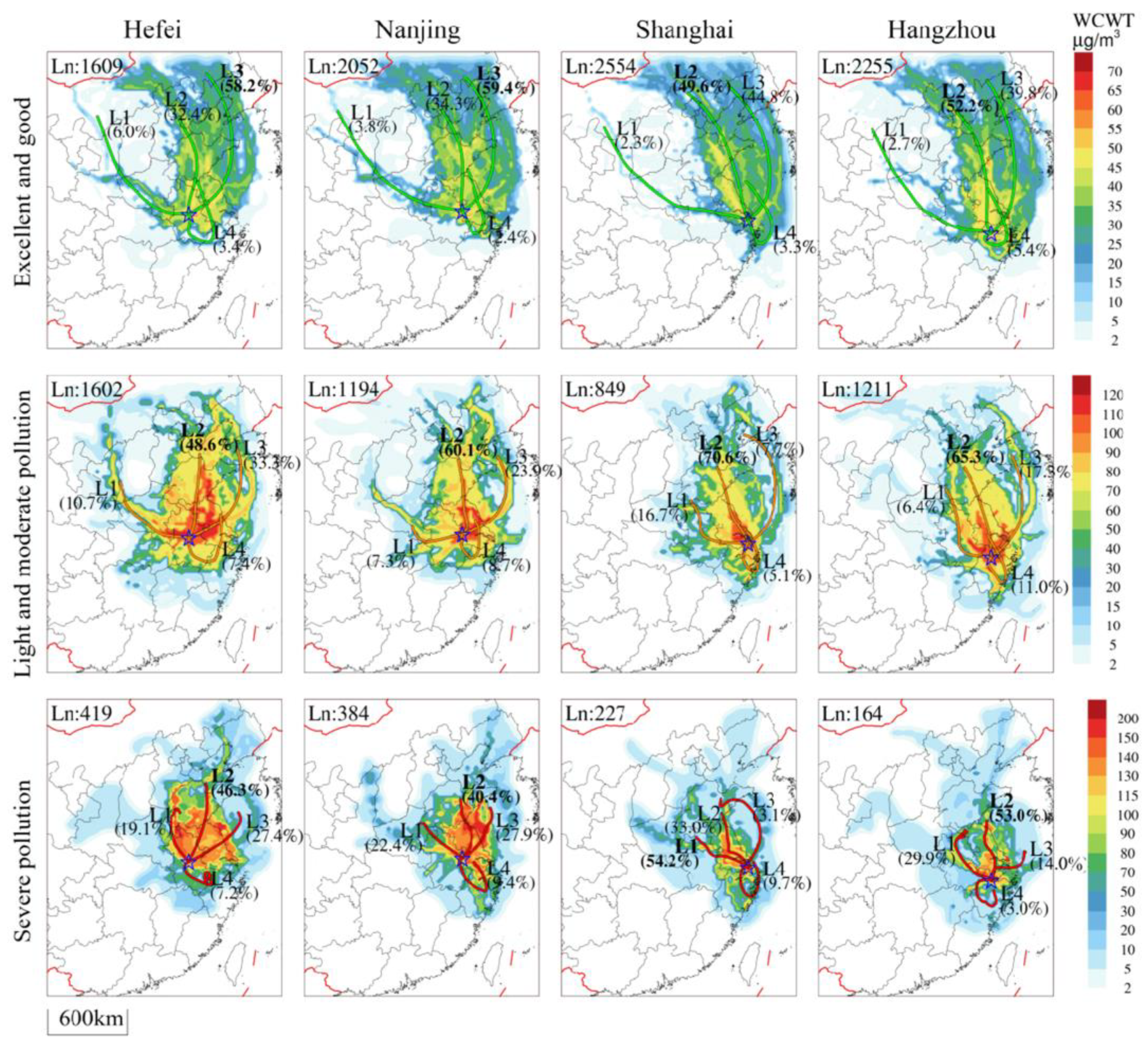
Disclaimer/Publisher’s Note: The statements, opinions and data contained in all publications are solely those of the individual author(s) and contributor(s) and not of MDPI and/or the editor(s). MDPI and/or the editor(s) disclaim responsibility for any injury to people or property resulting from any ideas, methods, instructions or products referred to in the content. |
© 2024 by the authors. Licensee MDPI, Basel, Switzerland. This article is an open access article distributed under the terms and conditions of the Creative Commons Attribution (CC BY) license (https://creativecommons.org/licenses/by/4.0/).
Share and Cite
Pan, Y.; Zheng, J.; Fang, F.; Liang, F.; Tong, L.; Xiao, H. A Comprehensive Study on Winter PM2.5 Variation in the Yangtze River Delta: Unveiling Causes and Pollution Transport Pathways. Atmosphere 2024, 15, 1037. https://doi.org/10.3390/atmos15091037
Pan Y, Zheng J, Fang F, Liang F, Tong L, Xiao H. A Comprehensive Study on Winter PM2.5 Variation in the Yangtze River Delta: Unveiling Causes and Pollution Transport Pathways. Atmosphere. 2024; 15(9):1037. https://doi.org/10.3390/atmos15091037
Chicago/Turabian StylePan, Yong, Jie Zheng, Fangxin Fang, Fanghui Liang, Lei Tong, and Hang Xiao. 2024. "A Comprehensive Study on Winter PM2.5 Variation in the Yangtze River Delta: Unveiling Causes and Pollution Transport Pathways" Atmosphere 15, no. 9: 1037. https://doi.org/10.3390/atmos15091037





